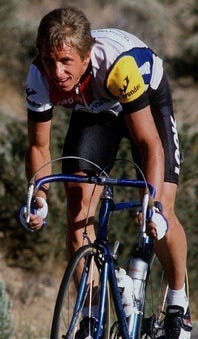
Maybe you’ve heard of Greg LeMond. Maybe you haven’t.
And if his name doesn’t ring familiar, maybe it should.
LeMond, 64, was the first American cyclist to win the Tour de France, one of the two or three most-watched sporting events in the world. And with the doping-era disqualifications of Lance Armstrong and Floyd Landis, LeMond is the only American who has won the Tour.
On July 9, LeMond will visit the Capitol to receive the Congressional Gold Medal, the highest civilian honor Congress can bestow, on par with the Presidential Medal of Freedom. Congress approved the medal in 2020, but the pandemic forced a delay in awarding it.
Since 1776, Congress has awarded only a few Gold Medals to athletes. Honorees include boxer Joe Louis, tennis giant Billie Jean King, Olympian Jesse Owens and golfer Jack Nicklaus.
Why is Congress giving Greg LeMond a medal?
In the United States, cycling is mostly recreational. In Europe and much of the rest of the world, it is a major competitive sport, and LeMond is one of its legends.
LeMond was a once-in-a-generation talent. Born in California in 1961, he entered competitive cycling in the 1970s amid a modest American cycling boom, an era lovingly captured in the classic 1979 film “Breaking Away.”
In a sense, Greg LeMond’s story is a real-life “Breaking Away.”
In the underground competitive cycling scene of his era, LeMond was so much better than everyone else that officials let him race against older boys. He beat them anyway.
LeMond decamped to Europe in 1980 and soon proved himself the most talented young rider on that continent, against much stiffer competition.
The rest of LeMond’s career unfolded with the sort of high drama you mostly see in movies. (In fact, actor Ben Stiller is said to be making a movie about LeMond’s 1986 Tour victory.)
In the summer of ‘86, LeMond captivated the cycling world by claiming America’s first Tour win, an epic duel against another all-time great, Frenchman Bernard Hinault.
All of France seemed set on denying LeMond his victory: Fans, journalists, fellow cyclists and even LeMond’s own teammates, not to mention Hinault himself. Not for nothing did Hinault earn the nickname “The Badger.”
The late Richard Moore, a Scottish writer, recounted the 1986 Tour in a classic cycling book, “Slaying the Badger.”
LeMond staged one of sport’s greatest comebacks
LeMond should have gone on to win the Tour in 1987 and 1988: He was that much better than the rest of the peloton.
But in April 1987, a few months before the next Tour, LeMond nearly died. He was turkey-hunting on a family ranch in rural California. A relative shot him by accident, piercing his body with dozens of shotgun pellets. By the time a helicopter delivered him to a hospital, LeMond had almost bled out.
After the accident, LeMond could barely walk, let alone pedal. And yet, over the next two years, he staged a spectacular comeback. He entered races he could not finish, then finished races he could not win. By the summer of 1989, LeMond had regained his form. He entered the Tour that year and quickly proved he was capable of winning it again.
The 1989 Tour pitted LeMond against another Frenchman: Laurent Fignon, a two-time Tour winner who was gunning for his third victory.
The 1986 edition of cycling’s premier event had been a great Tour. The 1989 edition would be widely remembered as the greatest Tour of all time.
The Tour de France plays out over 21 days of racing and covers more than 2,000 miles. Each cyclist’s time is recorded at the end of every stage. The rider with the shortest overall time at the end wins the race. By the finish, the victor often commands a lead of five or 10 minutes.
And that’s why the 1989 Tour captivated the world: It was really, really close.
After the second stage of racing, LeMond led Fignon by 51 seconds in cumulative time. After Stage 5, Fignon led by five seconds. After Stage 10, LeMond led by seven seconds. And so on.
By the final day of racing, July 23, 1989, Fignon held a 50-second lead over LeMond. The last stage was an individual time trial: A race against the clock, each cyclist going all out for 15 miles, riding alone into Paris as the stopwatch ticked.
The course was short and flat, and almost no one thought LeMond had a chance of riding it 50 seconds faster than Fignon to claim victory on the Champs-Élysées.
The final moments of that time trial delivered some of the most exhilarating live sports ever broadcast. Both Fignon and LeMond rode the race of their lives, but LeMond rode faster. At the finish, he had beaten Fignon by a margin of eight seconds.
In more than a century of racing, the 1989 Tour remains the closest ever. LeMond had staged one of the greatest comebacks in the history of American sports.
‘The True King of American Cycling’
Many years later, I wrote a biography of LeMond, with the 1989 Tour as its centerpiece. It published in 2018 as “The Comeback: Greg LeMond, the True King of American Cycling, and a Legendary Tour de France.”
I hoped LeMond might one day become as well-known as Lance Armstrong, the Texan cyclist who won a record seven Tours between 1999 and 2005. Armstrong was perhaps the most celebrated athlete in America until a doping investigation brought him down.
Shortly after my book came out, I received an email from U.S. Rep. Mike Thompson, a Democrat from California, LeMond’s birthplace.
Thompson was a cyclist. He had read my book, and he wanted to honor LeMond.
Some months later, Thompson introduced legislation to award LeMond the Congressional Gold Medal. It was an uphill battle, but Thompson collected the necessary support: a supermajority, two-thirds of the House and two-thirds of the Senate.
On December 4, 2020, President Donald Trump signed the Greg LeMond Congressional Gold Medal Act into law.
“More than any other cyclist in our history,” Thompson said on the House floor, “Greg LeMond was the epitome of the ‘Breaking Away’ culture: A young kid on a bike, trying to do things no American had ever done.”
